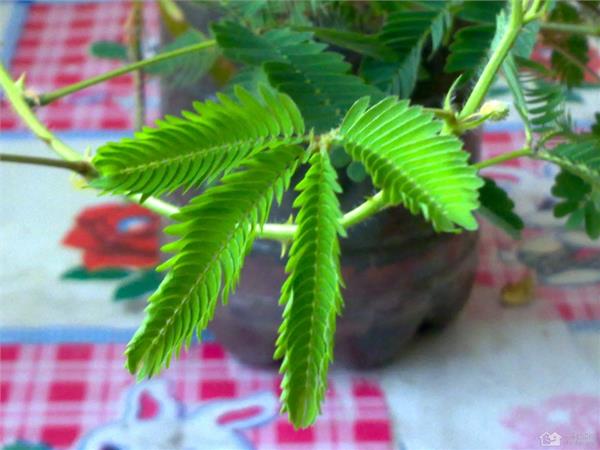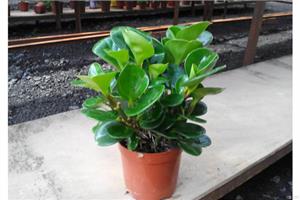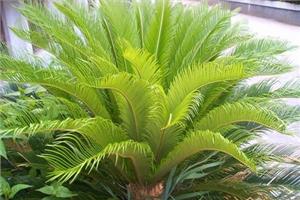The characteristics of mimosa and the reasons for its "shyness"
Mimosa, native to tropical America, is a perennial herb of the genus Mimosa of Leguminosae. Because of its unique physiological habits, it has many nicknames, such as Mimosa, Mimosa and so on.

First, the characteristics of mimosa
1. The most important feature of mimosa is that when it is stimulated (such as touching), the leaves of mimosa will contract and come together. If the stimulus is strong, the stimulus will be quickly transmitted to the adjacent leaflets, and even to the entire compound leaflet, causing the petiole to droop. If the stimulation intensity is larger, it can even make the leaflets of the whole plant close and the compound leaves droop. But after a period of time, the original state can be restored. Mimosa also responds quickly to vibration and is stimulated 0. The reaction begins after 1 s and is completed in a few seconds.
2. Mimosa also closes the leaflets and the petiole droops in the dark, and in the daytime, when some of the leaflets are shaken, they also close in pairs. It is more sensitive when the light is weak, and the water in the leaf pillow usually supports the leaf, but when it is stimulated by an external force, the water in the leaf pillow will immediately flow elsewhere, closing the leaves of the mimosa. In addition, it automatically contracts at night (that is, sleep exercise). This uniqueness is the source of the mimosa name and nickname.
3. Because of its strong vitality and messy growth, mimosa is classified as grass in many places, but in fact it will blossom. Mimosa blossoms from July to October every year, but its flowering period is so short that it dies after flowering for less than two days. The flower is pink, the head is spherical and shaped like a fluffy ball. It will also bear pods after flowering, and the fruit is flat and round.
Second, the reason why the mimosa is "shy"
The main results are as follows: 1. The mimosa cells are supported by the reticular protein "actin". When mimosa produces closed movement, the phosphoric acid of actin will fall off. As long as the mimosa is allowed to absorb compounds that do not let the phosphoric acid fall off, the touch will not change. When the thigh actin bundle is dispersed, the cells are destroyed, resulting in water running out, resulting in closed movement. Actin is commonly found in the muscle fibers of animals and is related to muscle stretching. Unexpectedly, it also exists in mimosa, which can be said to be quite rare.
At the base of the petiole and at the base of the leaflet of the compound leaf, there is a relatively inflated part called the leaf pillow. The leaf pillow is the most sensitive to stimuli. As soon as it touches the leaf, the stimulus immediately spreads to the leaf pillow at the base of the petiole, causing the two small leaves to close, with greater kinetic force, not only to the leaflet pillow, but also quickly to the leaf pillow at the base of the mimosa petiole, and the whole petiole droops.
3. Because the inner leaf has a large vacuole, and in the position of the leaf and petiole, there is a scientific name called the leaf pillow. When these parts are stimulated, some of the relatively low potential receptive cells in the interior will immediately release water, and then the petiole will droop, and the leaf will lose the expansion between the internal cells due to the loss of water, which makes the leaf close. In fact, it will also close at night, in fact, it is all caused by the pressure of internal cell expansion. In fact, its principle is the same as catching Cordyceps sinensis. For the leaf pillow, it is sensitive to external stimuli. When it is stimulated, the cell sap in the cells of the leaf pillow will be discharged, thus making the internal pressure unbalanced, which will make the leaves closed and produce shy reflection. In fact, the shyness of mimosa has a lot to do with the environment of its birthplace. The birthplace of mimosa is tropical South America, which is often accompanied by heavy rains. When Rain Water falls, the mimosa will close its leaves in time to avoid the damage of the storm and protect itself.
4. The shyness principle of mimosa has a lot to do with its original environment. Because in the tropics, there is plenty of water and there is often rainy weather, and mimosa closes its leaves in time to prevent wind and rain from damaging the leaves, which is also a sign of natural evolution.
These are the reasons why mimosa is shy. I believe you will like this plant more after you have seen it.
Related
- Wuhan Hospital Iron Tree Blooming Result Was Instantly Frightened by the Gardener Master
- Which variety of camellia is the most fragrant and best? Which one do you like best?
- What is the small blue coat, the breeding methods and matters needing attention of the succulent plant
- Dormancy time and maintenance management of succulent plants during dormancy
- Minas succulent how to raise, Minas succulent plant pictures
- What are the varieties of winter succulent plants
- How to raise succulent plants in twelve rolls? let's take a look at some experience of breeding twelve rolls.
- Attention should be paid to water control for succulent plants during dormant period (winter and summer)
- Watering experience of twelve rolls of succulent plants
- Techniques for fertilizing succulent plants. An article will let you know how to fertilize succulent plants.



